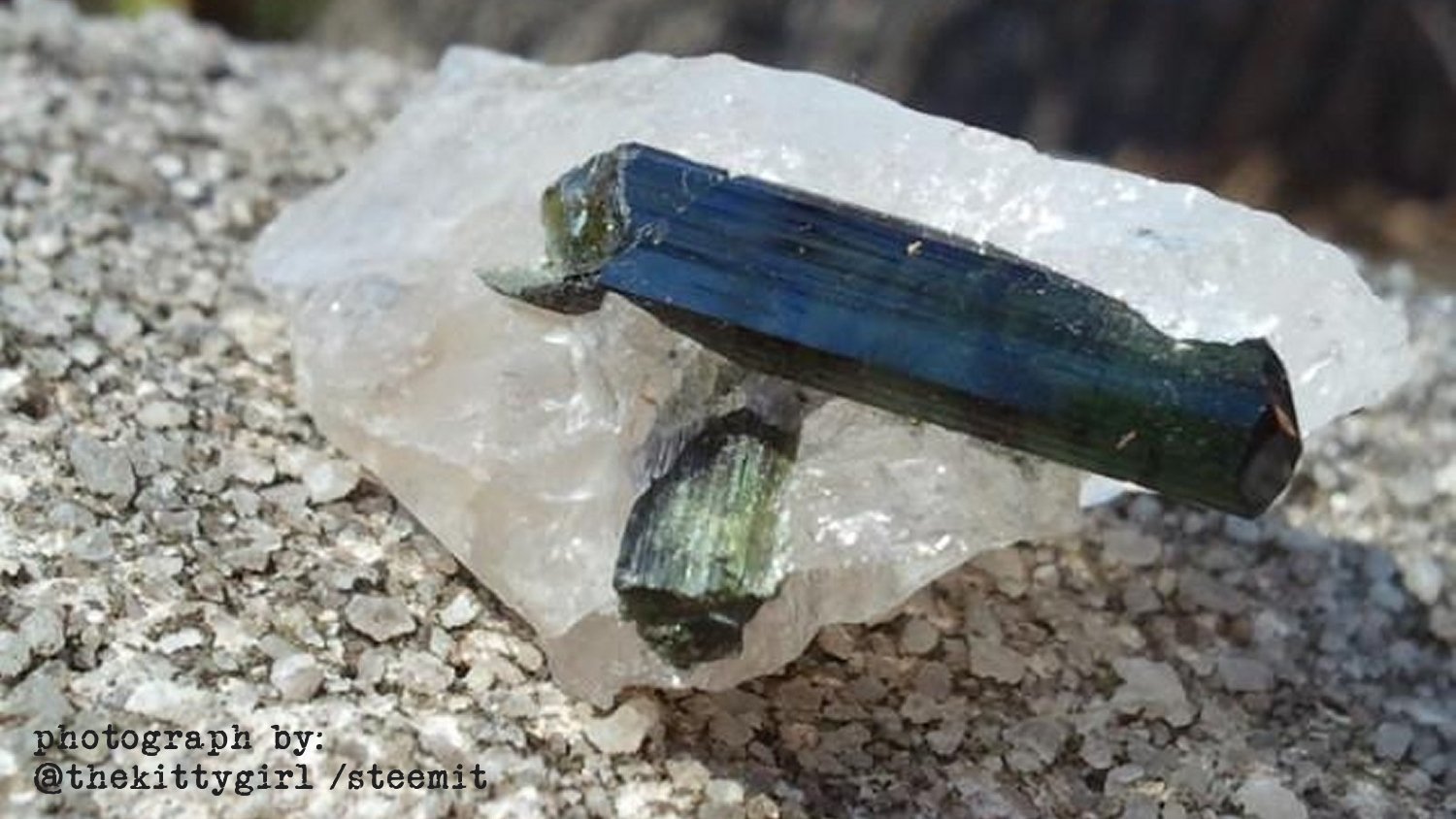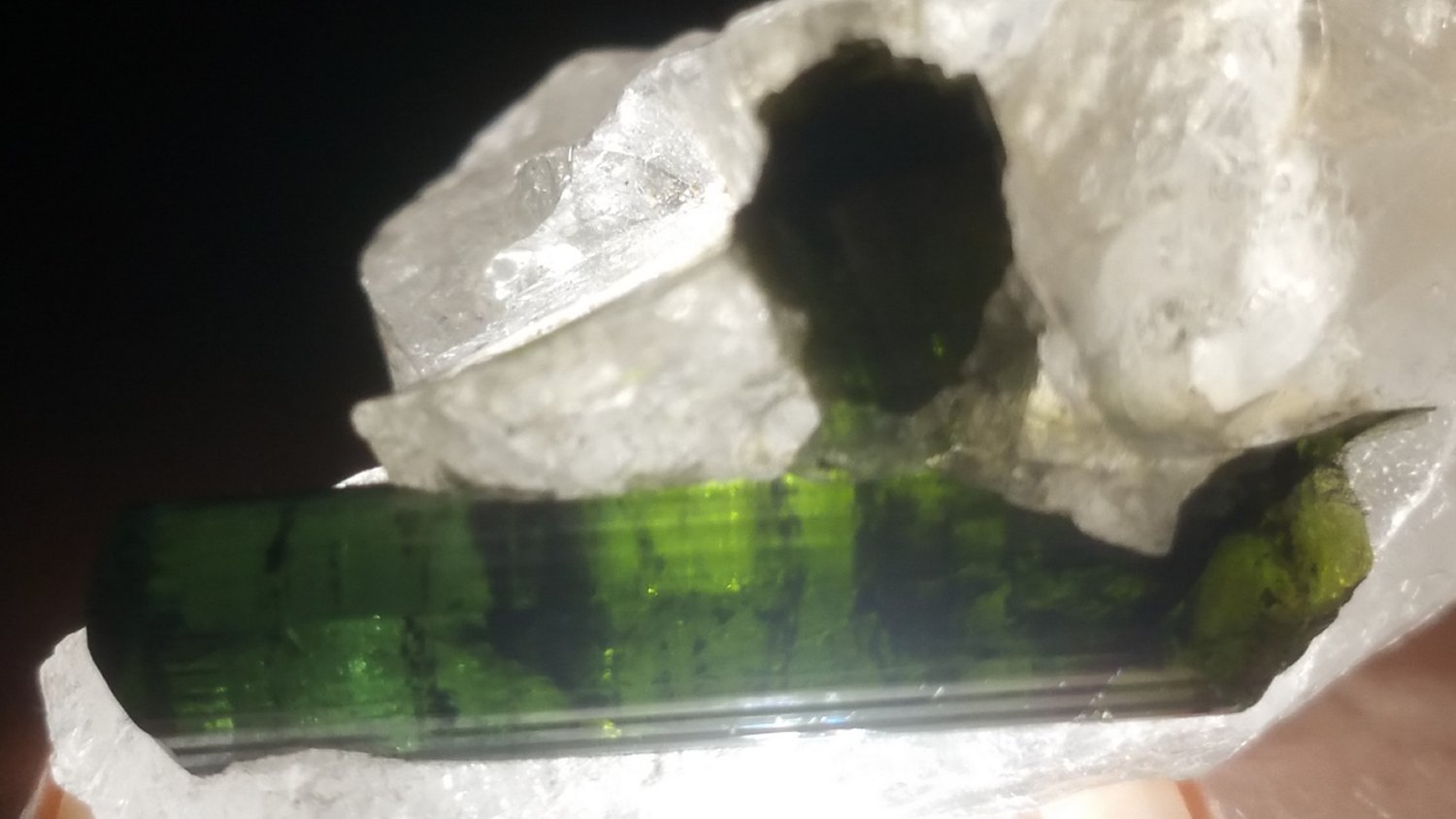One of the specimens in my mineral collection consists of two tourmaline crystals on a matrix of white calcite.

~photo by me~
The long crystal on top looks indigo blue in natural lighting, but it is, indeed, green if one shines a very bright light through it. To do this, I used the LED light in my cellphone, turned the specimen upside-down to put the larger crystal closer to the light, and was able to obtain the following photo:

~photo by me~
Tourmaline is described as a boron silicate mineral because it typically contains (BO
3)
3, but a large variety of other elements combine in various ways to comprise any given tourmaline crystal. This makes tourmaline one of the most complex of all the mineral varieties. To illustrate the complexity of this mineral, here is the chemical formula:
 3
3  6 (
6 ( 6O18) (BO3)3
6O18) (BO3)3  3
3
where:
 can be calcium, sodium, potassium, or (□) vacant
can be calcium, sodium, potassium, or (□) vacant can be lithium, magnesium, iron2+, iron3+, manganese2+, zinc, aluminum, chromium3+, vanadium3+, titanium4+, or (□) vacant
can be lithium, magnesium, iron2+, iron3+, manganese2+, zinc, aluminum, chromium3+, vanadium3+, titanium4+, or (□) vacant can be magnesium, aluminum, iron3+, chromium3+, vanadium3+
can be magnesium, aluminum, iron3+, chromium3+, vanadium3+ can be silicon, aluminum, or boron
can be silicon, aluminum, or boron can be a hydroxide ion, or oxygen
can be a hydroxide ion, or oxygen can be a hydroxide ion, fluorine, or oxygen
can be a hydroxide ion, fluorine, or oxygen
 😱
😱
I can't even begin to fathom how many permutations of the above formula are possible, but it is a rather large amount. However, there are 33 common and significant variations recognized by the International Mineralogical Association, listed in the Wikipedia article in the sources at the end of this post.
Different permuations can yield crystals of different colors, and some of those permutations are common-enough to have names of their own. For example, a tourmaline crystal that has the chemical permutation NaMg3Al6Si6O18(BO3)3(OH)3OH is typically brown in color and is called "Dravite," whereas a tourmaline crystal that is composed of □(LiAl2)Al6Si6O18(BO3)3(OH)3OH [where '□' indicates a vacancy in the 'X' position] is pink to light-tan in color and is called "Rossmanite." The most common tourmaline is the one called "Schorl" with a chemical formula NaFe2+3Al6Si6O18(BO3)3(OH)3OH that makes it black in color.
Much more information plus beautiful photos of different varieties of tourmaline can be found at the links below, epecially the Minerals.net website! 💎
SOURCES
2 Wikipedia: "Tourmaline"
1 Minerals.net: "The Gemstone Tourmaline"
2 Geology.com: Tourmaline: Earth’s most colorful mineral and gemstone



 3
3  6 (
6 ( 6O18) (BO3)3
6O18) (BO3)3  3
3
 can be calcium, sodium, potassium, or (□) vacant
can be calcium, sodium, potassium, or (□) vacant can be lithium, magnesium, iron2+, iron3+, manganese2+, zinc, aluminum, chromium3+, vanadium3+, titanium4+, or (□) vacant
can be lithium, magnesium, iron2+, iron3+, manganese2+, zinc, aluminum, chromium3+, vanadium3+, titanium4+, or (□) vacant can be magnesium, aluminum, iron3+, chromium3+, vanadium3+
can be magnesium, aluminum, iron3+, chromium3+, vanadium3+ can be silicon, aluminum, or boron
can be silicon, aluminum, or boron can be a hydroxide ion, or oxygen
can be a hydroxide ion, or oxygen can be a hydroxide ion, fluorine, or oxygen
can be a hydroxide ion, fluorine, or oxygen 😱
😱







